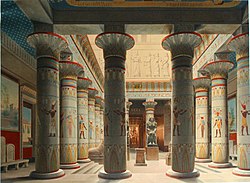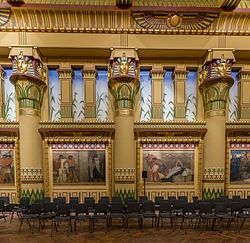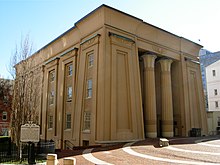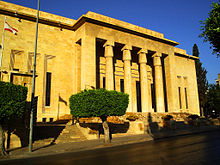Egyptian Revival architecture
   Top: The Egyptian Hall in London (1812-destroyed in 1905); Centre: 1862 lithograph of the Aegyptischer Hof (English: Egyptian court), from the Neues Museum (Berlin); Bottom: Interior of the Temple maçonnique des Amis philanthropes in Brussels (Belgium) | |
| Years active | Late 18th-present-present |
|---|---|
Egyptian Revival is an architectural style that uses the motifs and imagery of ancient Egypt. It is attributed generally to the public awareness of ancient Egyptian monuments generated by Napoleon's conquest of Egypt and Admiral Nelson's defeat of the French Navy at the Battle of the Nile in 1798. Napoleon took a scientific expedition with him to Egypt. Publication of the expedition's work, the Description de l'Égypte, began in 1809 and was published as a series through 1826. The size and monumentality of the façades discovered during his adventure cemented the hold of Egyptian aesthetics on the Parisian elite. However, works of art and architecture (such as funerary monuments) in the Egyptian style had been made or built occasionally on the European continent and the British Isles since the time of the Renaissance.
History[]
Egyptian influence before Napoleon[]
Likely inspired by ancient Roman practice, Europeans would both resume importing and begin copying Egyptian obelisks to sit in town squares in the early modern period. The most important example is probably the Obelisk of Domitian, a copy erected in 1651 by Bernini on top of the Fontana dei Quattro Fiumi in Piazza Navona, Rome. It influenced the obelisk constructed as a family funeral memorial by Sir Edward Lovatt Pierce for the Allen family at Stillorgan in Ireland in 1717, one of several Egyptian obelisks erected in Ireland during the early 18th century. Others may be found at Belan, County Kildare; and Dangan, County Meath. The Casteltown Folly in County Kildare is probably the best known, albeit the least Egyptian-styled.
Egyptian buildings had also been built as garden follies. The most elaborate was probably the one built by Frederick I, Duke of Württemberg in the gardens of the Château de Montbéliard. It included an Egyptian bridge across which guests walked to reach an island with an elaborate Egyptian-influenced bath house. Designed by the duke's court architect, Jean Baptiste Kleber, the building had a billiards room and a bagnio.
Post-Napoleonic era[]

New after the Napoleonic invasion was a sudden increase of the number of works of art and the fact that, for the first time, entire buildings began to be built to resemble those of ancient Egypt. In France and Britain this was at least partially inspired by successful war campaigns undertaken by each country while in Egypt.

According to , the 1798 Karlsruhe Synagogue, an early building by the influential Friedrich Weinbrenner was "the first large Egyptian building to be erected since antiquity."[1] According to Diana Muir Appelbaum, it was "the first public building (that is, not a folly, stage set, or funeral monument) in the Egyptian revival style."[2] The ancient Egyptian influence was mainly shown in the two large engaged pylons flanking the entrance; otherwise the windows and entrance of the central section were pointed arches, and the overall plan conventional, with Neo-Gothic details.
Among the earliest monuments of the Egyptian Revival in Paris is the Fontaine du Fellah, built in 1806. It was designed by François-Jean Bralle. A well-documented example, destroyed after Napoleon was deposed, was the monument to General Louis Desaix in the Place des Victoires was built in 1810. It featured a nude statue of the general and an obelisk, both set upon an Egyptian Revival base.[3] Another example of a still standing site of Egyptian Revival is the Egyptian Gate of Tsarskoe Selo, built in 1829.
A street or passage named the Place du Caire or Foire du Caire (Fair of Cairo) was built in Paris in 1798 on the former site of the convent of the "Filles de la Charité". No. 2 Place du Caire, from 1828, is essentially in overall form a conventional Parisian structure with shops on the ground floor and apartments above, but with considerable Egyptianizing decoration including a row of massive Hathor heads and a frieze by sculptor J. G. Garraud.[4]
One of the first British buildings to show an Egyptian Revival interior was the newspaper office of the Courier on the Strand in London. It was built in 1804 and featured a cavetto (coved) cornice and Egyptian-influenced columns with palmiform capitals.[5] Other early British examples include the Egyptian Hall in London, completed in 1812, and the Egyptian Gallery, a private room in the home of connoisseur Thomas Hope to display his Egyptian antiquities, and illustrated in engravings from his meticulous line drawings in his book Household Furniture (1807), were a prime source for the Regency style of British furnishings.
Later revivals[]

Egyptian Revival architecture enjoyed considerable popularity in other countries as well. The first Egyptian Revival building in the United States was the 1824 synagogue building of Congregation Mikveh Israel Synagogue in Philadelphia, Pennsylvania[6] It was followed by a series of major public buildings in the first half of the 19th century including the 1835 Philadelphia County Prison, Philadelphia, Pennsylvania, United States, the 1836 Fourth District Police Station in New Orleans and the 1838 New York City jail known as the Tombs. Other public buildings in Egyptian style included the 1844 Old Whaler's Church in Sag Harbor, New York, the 1846 First Baptist Church in Essex, Connecticut, the 1845 Egyptian Building of the Medical College of Virginia in Richmond and the 1848 United States Custom House in New Orleans. The most notable Egyptian structure in the United States was the Washington Monument, begun in 1848, this obelisk originally featured doors with cavetto cornices and winged sun disks, later removed. The National World War I Museum and Memorial in Kansas City, Missouri is another example of Egyptian revival architecture and art.[7]









The South African College in the then-British Cape Colony features an "Egyptian building" constructed in 1841; the Egyptian Revival building of the Cape Town Hebrew Congregation is also still standing.
The York Street Synagogue was Australia's first Egyptian revival building, followed by the Hobart Synagogue, the Launceston Synagogue and the Adelaide Hebrew Congregation, all by 1850. The earliest obelisk in Australia was erected at Macquarie Place, Sydney in 1818.[8]
The expeditions that eventually led to the discovery in 1922 of the treasure of Tutankhamun's's tomb by archaeologist Howard Carter resulted in a 20th-century revival. The revival during the 1920s is sometimes considered to be part of the Art Deco style. This phase gave birth to the Egyptian theatre movement, largely confined to the United States. The Egyptian Revival decorative arts style was present in furniture and other household objects, as well as in architecture.
List of buildings[]
- 18–12 BC Pyramid of Cestius, Rome
- 1798 Karlsruhe Synagogue[9]
- circa 1820: Memorial to Elizabeth Donkin, Port Elizabeth, South Africa.
- 1822: Egyptian temple in Łazienki Park, Warsaw, Poland
- 1824: 42 Fore Street in Hertford, known locally as the Egyptian House, is an English Heritage Grade II listed building built on the site of a former inn.[10] A grocery store from the Victorian era until the 1960s, now a restaurant.[11]
- 1824: Congregation Mikveh Israel Synagogue in Philadelphia, Pennsylvania, United States. Designed by William Strickland. The congregation left this building in 1860; it was demolished in 1902.[12]
- 1825–1826: Egyptian Bridge in St. Petersburg. Collapsed on 20 January 1905, although the new bridge (1955) incorporated sphinxes and several portions of it remains.
- 1826–1830: Groton Monument in Groton, Connecticut, United States
- 1827–1830: in Tsarskoe Selo, St. Petersburg
- 1835: Philadelphia County Prison, Philadelphia, Pennsylvania, United States. Designed by Thomas Ustick Walter, it was demolished in 1968.
- 1835–1837: The Egyptian House in Penzance, Cornwall. Built by local bookseller John Lavin as a museum, it is still standing.
- 1836-1840: Temple Works, a former flax mill in the industrial district of Holbeck in Leeds, UK. Built for textile industrialist John Marshall and held the distinction of being the largest single room in the world when it was built.
- 1836: on Rousseau Street in New Orleans. Designed by Benjamin Buisson, it originally served as a jail and police station. Later altered significantly; now used by the Knights of Babylon krewe for Mardi Gras float storage.
- 1838: The Tombs, a court and jail complex in New York City by John Haviland. Demolished and replaced by a new building in 1902.
- 1838: Pennsylvania Fire Insurance building, Philadelphia [1] by John Haviland. Extant.
- 1838–1839: The Egyptian Avenue and inner circle of the Lebanon Circle in Highgate Cemetery, London.
- 1838–1840: Abney Park Temple Lodges, Hackney, London.
- 1840: Gates of the Granary Burying Ground, by Isaiah Rogers, in Boston, Massachusetts, United States.
- 1842: Croton Distributing Reservoir in New York City.
- 1827–1843: Bunker Hill Monument in Charlestown, Boston, Massachusetts, United States.
- 1843: Gates and gatehouses of Mount Auburn Cemetery in Cambridge, Massachusetts, United States. Designed by Jacob Bigelow.
- 1843: Union Suspension Bridge, Between Ottawa and Gatineau, Quebec, Canada. Replaced in 1889 with another bridge.
- 1844: Old Whaler's Church, Sag Harbor, New York, United States. Designed by Minard Lafever.
- 1844: Launceston Synagogue, Launceston, Tasmania, Australia.
- 1845: Hobart Synagogue, Hobart, Tasmania, Australia.
- 1845: The brownstone entry gates of the Grove Street Cemetery, by Henry Austin, New Haven, Connecticut, United States
- 1845: Egyptian Building of the Medical College of Virginia in Richmond, Virginia, United States.[13]
- 1846: First Baptist Church in Essex, Connecticut
- 1846–1848: Old Synagogue at Canterbury, England, United Kingdom.
- 1848: Washington Monument, Washington, D.C., United States. In addition to taking the form of an obelisk, it originally featured doors with cavetto cornices and winged sun disks, later removed.
- 1848: United States Custom House in New Orleans.
- 1849: , the second-oldest lighthouse in South Africa, also called the "Pharos of the South".
- 1851: Downtown Presbyterian Church, Nashville, Tennessee, United States. Designed by William Strickland.[14] It was the church of US presidents Andrew Jackson and James K. Polk.
- 1856: Egyptian Temple housing elephants at the Antwerp Zoo. Designed by Charles Servais.
- 1856: Skull and Bones undergraduate secret society at Yale University, New Haven, Connecticut in the United States. Architect's attribution in dispute, but may also be Henry Austin of the Grove Street Cemetery gates.
- 1862–1864: Egyptian temple in the park of Stibbert Museum, Florence, Italy.
- 1867: in Queen's Park, Glasgow.
- 1870: The Egyptian Halls in Glasgow. Designed by Alexander Thomson.
- 1881–1889: Mausoleo Schilizzi in Naples, Italy.
- 1891: The built in 1891 near Wissant by the Belgian architect Edmond De Vigne
- 1914: Regional Studies Museum in Krasnoyarsk, Russia
- 1914: Scottish Rite Cathedral Meridian, Mississippi, United States.
- 1914: Masonic Temple in Charlotte, North Carolina, United States (1914–87).
- 1920: , Chicago, Illinois, United States. Designed by Paul Gerhardt.
- 1921: Louxor theater, Paris, France.
- 1921: Scottish Rite Temple in Mobile, Alabama, United States.
- 1921: National World War I Museum and Memorial, Kansas City, Missouri.
- 1922: Grauman's Egyptian Theatre, Los Angeles, California, United States.
- 1922: Reebie Storage Warehouse, Chicago, Illinois, United States. It features twin statues of Ramses II and the use of ancient Egyptian images and hieroglyphics. Reliefs depict ancient Egyptians moving grain on barges.
- 1923L Mobridge Masonic Temple, Mobridge, South Dakota, United States.
- 1923–1924: Peery's Egyptian Theater, Ogden, Utah, United States.
- 1922–1926: Mary G. Steiner Egyptian Theatre, Park City, Utah, United States.
- 1925–1926: Sphinx Head Society clubhouse, Cornell University, Ithaca, New York
- 1927: Emulation Hall, Melbourne, Australia
- 1927: Pythian Temple, New York City.
- 1927: Salt Lake City Masonic Temple, Salt Lake City, Utah
- 1927: The Egyptian Theatre, Boise, Idaho, United States.
- 1927: Empress Theatre, Montreal, Quebec, Canada.
- 1924–1929: Lenin's Mausoleum, Moscow, Russia. Designed by Aleksey Shchusev, it utilizes elements borrowed from the Pyramid of Djoser.
- 1926–1928: Carreras Cigarette Factory, Camden, London.
- 1928: Lincoln Theatre, Columbus, Ohio, United States. Has an Egyptian revival interior.
- 1928–1929: Egyptian Theatre, DeKalb, Illinois, United States.
- 1929: Balsiger Ford Dealership, Klamath Falls, OR, United States.
- 1929: Fox Theatre, Atlanta, Georgia, United States. While the exterior is Moorish revival, the interior features extensive use of Egyptian revival design.
- 1933: Egyptian Theatre, Delta, Colorado, United States.
- 1934 Pyramid Theatre, Sale, Greater Manchester, UK (formerly a cinema, both independent and Odeon now a Sports Direct)
- 1930–1937: National Museum of Beirut, Beirut.
- 1934: Former Perth Girl's School, Perth, Western Australia, Australia.
- 1937: Manly Town Hall, Manly, New South Wales, Australia.
- 1939: Social Security Administration Building, Washington, D.C, United States.
- 1940: Mary E. Switzer Memorial Building, Washington, D.C, United States.
- 1939–1941: Marion Veterans Affairs Medical Center, Marion, Illinois, United States.
- 1966: Rosicrucian Egyptian Museum, San Jose, California, United States.
Post-modern variants[]
- 1989: Louvre Pyramid, Paris.
- 1991: Pyramid Arena, Memphis, Tennessee, United States.
- 1992: Cheesecake Factory, United States.
- 1993: Tama-Re, Eatonton, Georgia, United States. Demolished 2005.
- 1993: Luxor Hotel and Casino, Las Vegas, Nevada, United States.
- 1997: Wafi City, , Dubai UAE
- 1997: Sunway Pyramid, Bandar Sunway, Malaysia.
- 2001: Supreme Constitutional Court of Egypt building, Cairo.
- 2001: Scotiabank Theatre Chinook Centre, Calgary, Alberta
- 2010: Sohag International Airport terminal building, Sohag, Egypt
See also[]
- Egyptian Revival decorative arts
- Ancient Egyptian architecture
- Egyptian Revival architecture in the British Isles
References[]
- ^ , Frederich Weinbrenner: Architect of Karlsruhe, University of Pennsylvania Press, 1986. p. 92.
- ^ Diana Muir Appelbaum, "Jewish Identity and Egyptian Revival Architecture", Journal of Jewish Identities, 2012, 5(2) p. 7.
- ^ Curl, James Stevens (2005). The Egyptian Revival. Psychology Press. p. 276. ISBN 9780415361194.
- ^ James Stevens Curl, The Egyptian Revival, Routledge/* Post-Napoleonic era */ , London, 2005. p. 267.
- ^ Egyptomania: Egypt in Western Art, 1730–1930, Jean-Marcel Humbert, Michael Pantazzi and Christiane Ziegler, 1994, pp. 172–3
- ^ Diana Muir Appelbaum, "Jewish Identity and Egyptian Revival Architecture", Journal of Jewish Identities, 2012 5(2)
- ^ "Elements of the Museum and Memorial | National WWI Museum and Memorial". National WWI Museum and Memorial. 2013-03-01. Retrieved 2018-11-02.
- ^ Humbert, Jean-Marcel and Price, Clifford, eds., Imhotep Today: Egyptianizing Architecture, UCL Prewss, 2003, pp. 167 ff.
- ^ Appelbaum, Diana Muir (2012). "Jewish identity and Egyptian revival architecture". Journal of Jewish Identities. 5 (2): 1–25. doi:10.1353/jji.2012.0020. Archived from the original on 2015-10-25.
- ^ Historic England
- ^ Egytpian House, Hertford
- ^ The History of the Jews of Philadelphia from Colonial Times to the Age of Jackson, pages 365-366 (Philadelphia, Jewish Publication Society, 1956, 1975) by Edwin Wolf, II and Maxwell Whiteman
- ^ "Medical College of Richmond (now Egyptian Building, Medical College of Virginia) by Thomas S. Stewart". www.bluffton.edu. Archived from the original on 2006-01-12.
- ^ "History - Downtown Presbyterian Church". www.dpchurch.com. Archived from the original on 2015-03-24.
External links[]
 Media related to Egyptian Revival architecture at Wikimedia Commons
Media related to Egyptian Revival architecture at Wikimedia Commons
- Egyptian Revival architecture
- Architectural styles
- Revival architectural styles

